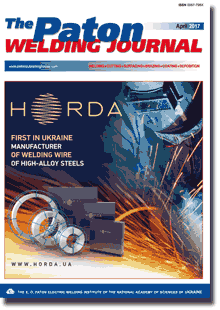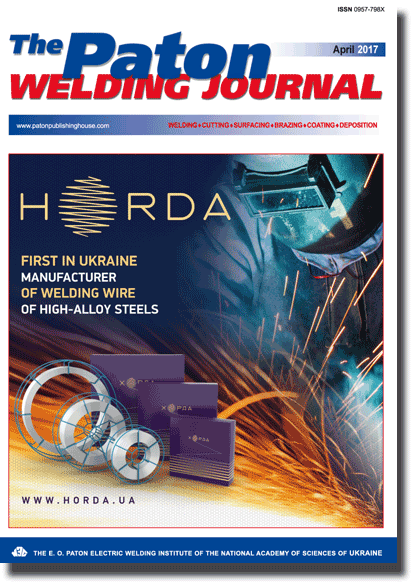| 2017 №04 (01) |
DOI of Article 10.15407/tpwj2017.04.02 |
2017 №04 (03) |

The Paton Welding Journal, 2017, #4, 10-13 pages
Effect of alternating magnetic field on magnetic properties, structure and stressed state of vessel steel welded joints
K.A. Yushchenko1, A.V. Mats2, I.M. Neklyudov2, V.I. Sokolenko2 and N.A. Chernyak2
1E.O. Paton Electric Welding Institute, NASU 11 Kazimir Malevich Str., 03680, Kiev, Ukraine. E-mail: office@paton.kiev.ua
2National Science Center Kharkov Institute of Physics and Technology 1 Akademicheskaya Str., 61108, Kharkov, Ukraine. E-mail: vsokol@kipt.kharkov.ua
Abstract
Earlier investigations showed that treatment of welded joints of reactor vessel steel 15Kh2NMFA with alternating magnetic field of commercial frequency significantly improves a complex of mechanical properties under conditions of uniaxial tension that is accompanied by decrease of a level of thermal stresses in a weld zone. Aim of the present work is study of the effect of magnetic treatment on magnetic characteristics, structure, level and distribution of residual stresses in the welded joint. Changes of stress-strain state in different areas of the welded joint were evaluated on data of X-ray diffraction and electron-microscopic examinations. It is shown that effect of alternating magnetic field results in decrease of a level of microstresses in a transition layer and balancing of spectrum of these stresses in all area of heat affect. Correlation of changes of initial magnetic susceptibility and microstresses in the transition layer and formation of expressed magnetic texture in the weld central part is noted. The mechanisms of changes of magnetic properties and structure at magnetic treatment of welded joint, which are related with activation of plastic microdisplacements and defect redistribution, were considered. Given method of magnetic treatment can be observed as magnetic tempering, providing rise of homogeneity of stress-strain state of welded joints. This promotes increase of their resistance to nucleation and propagation of cracks. 10 Ref., 1 Table, 3 Figures.
Keywords: welded joint, vessel steel, magnetic treatment, structure, internal stresses
Received: 21.02.17
Published: 17.04.17
References
- Makhnenko, V.I., Grigoryants, A.G., Kazimirov, A.A. (1981) Welding in USSR. Vol. 2: Theoretical principles of welding, strength and design. Moscow: Nauka.
- Neklyudov, I.M. et al. (2011) Effect of magnetic treatment on mechanical characteristics and thermal stresses of vessel plate welded joints. Fizika i Khimiya Obrabotki Materialov, 1, 84–88.
- Mitsek, A.I., Pushkar, V.N. (1978) Real crystals with magnetic order. Kiev: Naukova Dumka.
- Pat. 94178. Method of magnetic treatment of products from magnetic-ordered metallic alloys. 11.04.2011.
- Vonsovsky, S.V. (1971) Magnetism. Moscow: Nauka.
- Noskova, N.I. et al. (1986) Relaxation of residual stresses of metals in field of elastic oscillations. Problemy Prochnosti, 9, 67–72.
- Mishin, D.D. (1981) Magnetic materials. Moscow: Vysshaya Shkola.
- Arsenold, R.J. (1972) Microplasticity of bcc metals and solid solutions. Mechanisms of double conversions: Mikroplasticity, Moscow: Metallurgiya.
- Bernshtejn, M.L. (1968) Thermomagnetic treatment of steel. Moscow: Metallurgiya.
- Lesnik, A.G. (1976) Induced magnetic anisotropy. Kiev: Naukova Dumka.
Suggested Citation
K.A. Yushchenko, A.V. Mats, I.M. Neklyudov, V.I. Sokolenko and N.A. Chernyak (2017) Effect of alternating magnetic field on magnetic properties, structure and stressed state of vessel steel welded joints. The Paton Welding J., 04, 10-13.The cost of subscription/purchase order journals or individual articles
| Journal/Currency | Annual Set | 1 issue printed |
1 issue |
one article |
| TPWJ/USD | 384 $ | 32 $ | 26 $ | 13 $ |
| TPWJ/EUR | 348 € | 29 € | 24 € | 12 € |
| TPWJ/UAH | 7200 UAH | 600 UAH | 600 UAH | 280 UAH |
| AS/UAH | 1800 UAH | 300 UAH | 300 UAH | 150 UAH |
| AS/USD | 192 $ | 32 $ | 26 $ | 13 $ |
| AS/EUR | 180 € | 30 € | 25 € | 12 € |
| SEM/UAH | 1200 UAH | 300 UAH | 300 UAH | 150 UAH |
| SEM/USD | 128 $ | 32 $ | 26 $ | 13 $ |
| SEM/EUR | 120 € | 30 € | 25 € | 12 € |
| TDNK/UAH | 1200 UAH | 300 UAH | 300 UAH | 150 UAH |
| TDNK/USD | 128 $ | 32 $ | 26 $ | 13 $ |
| TDNK/EUR | 120 € | 30 € | 25 € | 15 € |
AS = «Automatic Welding» - 6 issues per year;
TPWJ = «PATON WELDING JOURNAL» - 12 issues per year;
SEM = «Electrometallurgy Today» - 4 issues per year;
TDNK = «Technical Diagnostics and Non-Destructive Testing» - 4 issues per year.


